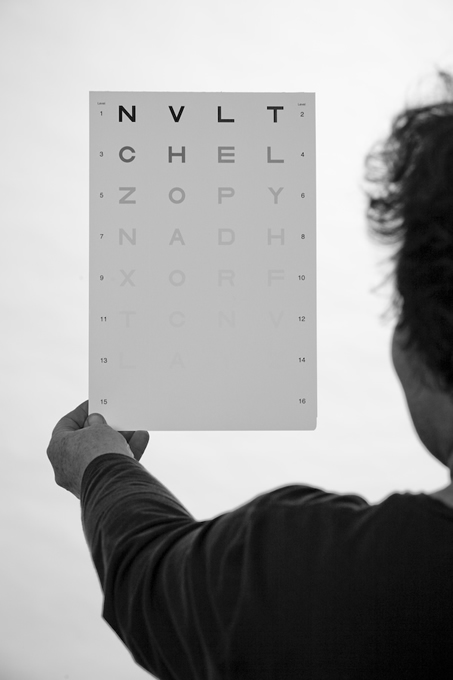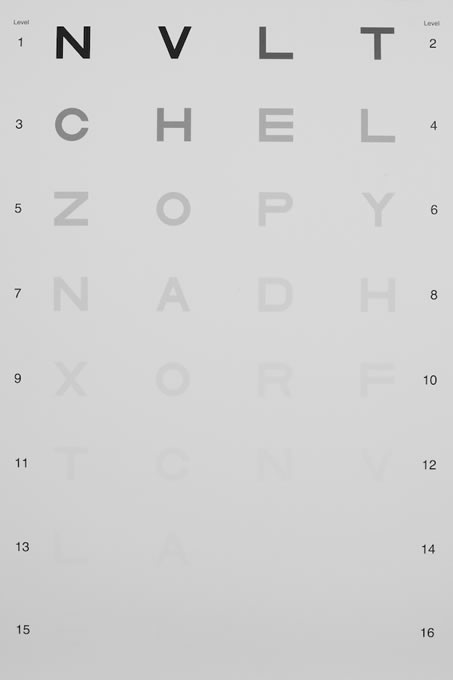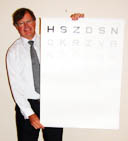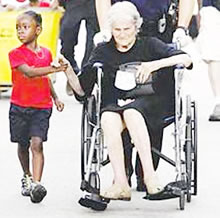Contrast
Sensitivity Test
What
is a Contrast sensitivity
test
A contrast sensitivity test, checks for the ability
to differentiate between light and dark (contrast).
This ability, is as much an important sense as 20/20,
allowing us to be able to carry out everyday tasks safely.
The
Hamilton-Veale Contrast Sensitivity Test
(photo below), is an effective means of monitoring potential
decreases in contrast sensitivity function over time.
Even though a person is provided with the best possible
refraction (glasses, etc...) they may still complain
of not seeing clearly. This problem is often related
to a loss of contrast sensitivity.

The
Hamilton-Veale Contrast Sensitivity Chart - Complete
Solution |

A
TEST FOR THE HIDDEN LOSS OF VISION
Eye specialists routinely test eyes for visual acuity,
20/20 or 6/6.
Seldom
do they test for the other most important functions
of vision; Fields and Contrast Sensitivity.
This
easy to understand chart ,will test for a loss in Contrast
Sensitivity. Loss of Contrast Sensitivity will indicate
a serious loss of visual function, and this loss is
usually a sign of eye disease.
Ophthalmic
professional advice should be sought if a loss in contrast
sensitivity is detected.
Remember
that a 20/20 result, will not always uncover a possible
hidden loss in contrast sensitivity.

“TWILIGHT”
Henry
Grunwald,was the long time editor in chief of “Time
Magazine” and Time Inc. Publications,
“In
1992, my wife Louise, and I rented a villa outside Florence.
The light in the house was inadequate, especially in
the gloomy, rainy weather of that October; the twenty-five
watt bulbs in the pseudo elegant sconces remind me of
those notoriously under lit Russian hotel rooms. One
afternoon, I picked up a carafe from a side table in
a particularly dark corner to pour water into a glass.
I missed the glass. I inveighed against the landlord,
who, I thought, was trying to save electricity with
those weak light bulbs, but I suspected that I might
need new glasses.
Back
in New York, quite unconcerned, I dropped in on the
nearest optician. In a darkened cubicle, he took me
through the usual eye test. I have worn glasses ever
since I was a teenager. Using both eyes, I read the
chart without difficulty, but when my right eye was
covered and I looked only through the left, I saw virtually
nothing. My right eye, on the other hand, was close
to normal and, as I realised later, saw for both. The
optician seemed embarrassed, and he took me through
the test again. The result was the same. "I think
you had better see an eye doctor," he said.”
Henry had unbeknowingly, lost the vision in his left,
probably non dominant eye, due to macular degeneration.
All
the time, he had been losing his Contrast Sensitivity.
That is one of the reasons he had trouble pouring the
glass of water in poor light.
We
recommend reading Henry Grunwald's book "Twilight;
Losing Sight, Gaining Insight." Available from
www.amazon.com
Example Case
Joshua
Spence has Rod/Cone dystrophy. He was diagnosed with
this problem aged 3 years. He is now 8 years of age
and is managing very well at school but his parents
were not able to understand what he could and could
not see.
They
had been to their eye specialist on many occasions and
knew that he could only see 6/36 with both eyes. They
could not understand why he could achieve so much with
this low visual acuity measure, but struggled with any
tasks in poor light.
He
was tested on the Hamilton-Veale Contrast Sensitivity
Chart. He only reached level 7 (see below) where as
most children reach level 13 or 14.

This
demonstrated clearly to Joshua's parents the reason
why he has difficulty in poorly lit conditions. As a
result his parents now know to provide him with ample
bright light to work in and to assist him when out and
about in poor light or at night.
THE
PELLI ROBSON CONTRAST SENSITIVITY CHART

This
chart is the Gold Standard. It is large, expensive,
difficult to find if you want to buy one, and as a result,
not used often enough in the clinical or self testing
setting.
The
accuracy of the chart is determined primarily by two
functions;
The accuracy of the calibration of the contrast on the
chart
The intrinsic variability due to the problematic nature
of the patients' responses.
(Arch. Ophthal . 41, 103-148, 1980.)
As
with visual acuity testing, due to numerous variables,
the gold standard chart also suffers from these difficulties.
Ie;
- day of testing (personal variables)
- test distance
- test illumination,
- font/type size and spacing.
Because
of these variables, (the size of the chart and its cost),
we believe, are the reason, contrast sensitivity is
not regularly tested.
Contrast sensitivity should always be tested in all
eye examinations.
It should also be used to test oneself, to detect any
visual loss over time.
MACULAR DEGENERATION
Macular
degeneration is the most common form of visual disability
in the Western World. Now labeled ARMD (Age Related
Macular Degeneration), it is increasingly prevalent
after the age of 65.
There
are two major types;
1. Wet: Where the weak blood vessels propagate at the
macular and leak
2. Dry : Where the retinal cells at the macular wither
and die.
The
initial consequence of ARMD is a loss of visual acuity
and often a distortion of images. Use a Amsler's chart
to detect swelling at the macular and resultant distortion
on the chart.
A
loss on contrast sensitivity function is also observed
as more macular cells die. It is advised the Hamilton
Veale Contrast Sensitivity Chart be used in conjunction
with an Amslers
chart,to detect visual function loss, in all
cases with Macular Degeneration.

Amslers Chart |
CATARACTS
When
should my cataract be removed?
All
of us will get cataracts if we live long enough.
They
are simply a breakdown in the clarity of. the crystalline
lens in the eye. This haze causes a loss in visual acuity
20/20 and usually, a loss of contrast sensitivity.
As
a result, high contrast images (ie the Visual acuity
chart 20/20) can be seen, but objects with low contrast
are not seen. ie; in dark corners,during foggy conditions,looking
through fogged up windows and windscreens,in dark conditions,
and on hazy days.
Use
the Hamilton-Veale Contrast Sensitivity Test to detect
any loss.
If you record a loss in contrast sensitivity function,
see your eye specialist straight away, as your safety
may be at risk.
GLAUCOMA
Glaucoma
is a severe eye disease, which is on the increase in
the West and in Asia. It leads to a loss of the eye's
nerve fibre layer, resulting in field loss and a loss
in contrast sensitivity function.
All
persons who are diagnosed with glaucoma should have
a contrast sensitivity test. Each eye individually and
binocularly.
Patients
with glaucoma must be under the regular care of their
Eye Doctor. Advice on increasing contrast should be
given.
LOW
VISION
Low
vision is described as vision worse than 6/12 in the
best eye.
We
need 6/12 vision to drive a car or read newsprint. Those,
who can not pass this test, are at a huge disadvantage
,and are labeled with low vision.
Most
low vision clinics will measure a person's contrast
sensitivity function. If it is low ,the Low Vision Practitioner,
usually an optometrist or occupational therapist, will
advise the use of more contrast and more illumination.
Greater
contrast can be achieved by using task lighting.
- black objects on a white desk
- white tea cups and plates
- white lines on the edge of steps
(see illumination below)
Yellow
lenses will often increase contrast. Fishermen's sunglasses
will often cut down glare when outdoors and also increase
contrast.
ILLUMINATION
If
you have a low contrast sensitivity level (level 12-
level 7) on the Hamilton- Veale Contrast Sensitivity
Test you will need better illumination.
People
with age related macular degeneration (ARMD) and glaucoma,
often see better in bright light. Use moveable spotlights
or lamps that can be directed onto the work area for
tasks requiring close focus. Position the light so it
is not shining into the eyes, but directly at the task
at hand.
You
may need different levels of light for different tasks.
Reflector type bulbs are the best. It pays to experiment
with different wattages.
Make
the most of the light in your house. Skylights and high
windows will increase natural light without glare. When
redecorating, use light colours on walls and white on
the ceiling. Keep small powerful torches around the
house for seeing in cupboards and dark corners.
FALLS
The
John Hopkins University School of Medicine studied why
elderly people are likely to fall.
It
was shown that a low contrast sensitivity level was
significant even when there was good somatosensory feedback.
A
low contrast sensitivity level contributes to a poor
postural stability which leads to a 2x increase in the
likelihood of falling.
Turano
et al. Optom & Vision Science
Vol 71 Number 12 12/94 pg 761
Where as youngsters trip and recover, elderly trip and
fall. The number of injuries sustained by falls increases
with age. Along with a loss of contrast sensitivity
and osteoporosis, failing muscle tone, poorer proprioceptive
cues, falls in the elderly are much more common and
have a devastating affect on an older persons quality
of life.
Poor
vision is implicated in falls, and a loss of contrast
sensitivity function with age makes matters worse.

GLARE
Many
of us suffer from the effects of glare in the form of;
overhead lights, sun, reflections... etc. This is often
caused by the light being scattered when it enters the
eye due to cataracts.
Although
this visual acuity (20/20) may be good. Whenever light
from an indirect source enters the eye, ie; car headlights,
bright overhead super market lights and glare reduces
the ability to see clearly. This is called veiling glare.
You
can test for veiling glare using the Hamilton Veale
Contrast Sensitivity Test. Test each eye yourself under
normal conditions and measure the contrast sensitivity
level. Then, shine a torch into the eyes from a high
angle and measure the level again. If there is a moderate
cataract or other from of eye opacity present, the contrast
sensitivity level will be greatly reduced. If this is
the case your eye care specialist should be consulted
immediately.
CHILDREN'S
VISION
Children
who have low vision are seldom tested for visual fields
or contrast sensitivity. Despite the fact that a good
contrast sensitivity level and a wide field of vision
are more important for functioning vision than visual
acuity.
(Aitken S., Buultjens M. J. Vis. Imp. Blind 1991 85
107-173)
We
therefore recommend testing children, with low vision,
who can recognise letters, with the Hamilton-Veale Contrast
Sensitivity Test.
DRIVING
AND CONTRAST SENSITIVITY
We
have all experienced the difficulty of seeing through
a fogged up windscreen. Some eye conditions emulate
this effect, and result in a loss of contrast sensitivity.
If there is significant loss in the contrast sensitivity
level, when road conditions are poor. Ie; rain, fog,
smoke, mist or darkness, seeing the road will be very
difficult.
Drivers with a significant loss of contrast sensitivity
should be advised not to drive at night or in poor conditions
for their own safety and the safety of others.
|

